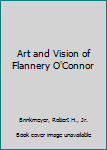Art and Vision of Flannery O'Connor
Select Format
Select Condition 
Book Overview
Brinkmeyer offers an explanation for the great depth and power of O'Connor's work, paying particular attention to the ways her art and audience bear upon her regnant Catholic vision This description may be from another edition of this product.
Format:Hardcover
Language:English
ISBN:0807114928
ISBN13:9780807114926
Release Date:January 1990
Publisher:Louisiana State University Press
Length:201 Pages
Weight:1.23 lbs.
Customer Reviews
1 rating
Explores the role of the narrator, types of characters and conflicting views Flannery O'Connor had o
Published by Thriftbooks.com User , 15 years ago
Suggests that O'Connor's "fiction arises from pressure and resistance" and draws "from voices both within and without herself" to test and challenge "her self-conception and her faith." Brinkmeyer acknowledges that his approach is partially based upon "the type of dialogic encounter" seen in Mikhail Bakhtin's work. Remarks that O'Connor's ability to give "free expression to her fundamentalist voice and to other voices of her self rather than monologically suppressing them is a crucial factor behind her artistic greatness." Explores "the crucial role that the narrator plays in the dynamic of O'Connor's fiction." Discusses Wise Blood and The Violent Bear It Away, and four stories: "Everything That Rises Must Converge," "The Artificial Nigger," "The Enduring Chill," and "The Lame Shall Enter First." Contends that "the narrator is a central figure in O'Connor's stories, and the narrator's relationship with both O'Connor and the story itself is fraught with tension." Sees the novels as displaying "an intensification of the narrator's perspective," and as having a subject matter that is openly religious and fundamentalist, resulting in "a more charged religious tone and tension." Argues that O'Connor "was pressured" by the narrator and, "as the narrator was, by the narrative, and particularly by the characters and their interactions." Notes that Bakhtin frequently discussed this dynamic and argued that "in the best fiction characters exert profound pressure on the author." Discusses three types of O'Connor's characters: intellectuals, artists, and prophet-freaks, chosen "because they all embody aspects of O'Connor that, at their extreme, come into potential conflict with her overriding Catholic ideology." Characters discussed include: Sheppard, Rayber, Joy/Hulga Hopewell, Mrs. Hopewell, Asbury, Julian, Calhoun, Mary Elizabeth, Singleton, Old Tarwater, Lucette Carmody, Hazel Motes, The Misfit, and the grandmother. Suggests that O'Connor had conflicting views regarding her readers, sometimes downplaying their significance while, at other times, arguing that readers "played a crucial role in artistic creation and that writers always had to be aware of, and to take account of" them. Explores these assertions and relates that because she kept her readers in mind when she wrote, O'Connor "entered into a profound interplay with aspects of herself usually suppressed by her ruling Catholicism," a process which brought her Catholic vision "under pressure and challenge." Adapted by R. Neil Scott from: Scott, R. Neil. FLANNERY O'CONNOR: AN ANNOTATED REFERENCE GUIDE TO CRITICISM. Milledgeville, GA: Timberlane Books, 2002. TimberlaneBooks.com




